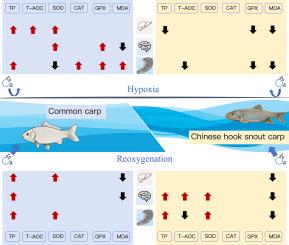Hypoxia and reoxygenation induced distinct patterns of response in antioxidant capacity between two cyprinid fish species
IF 2.2
3区 生物学
Q4 BIOCHEMISTRY & MOLECULAR BIOLOGY
Comparative Biochemistry and Physiology A-Molecular & Integrative Physiology
Pub Date : 2025-09-11
DOI:10.1016/j.cbpa.2025.111928
引用次数: 0
Abstract
Antioxidant defense represents a critical biological capacity enabling organisms to counteract homeostasis disruption and mitigate oxidative stress induced by environmental stressors, such as oxygen fluctuations. However, comparative studies investigating the differential responses of antioxidant defense systems to oxygen fluctuations across diverse animal species remain limited. In the present study, two common cyprinid species—common carp (Cyprinus carpio) and Chinese hook snout carp (Opsariichthys bidens)—maintained under normoxic conditions (> 7 mg L−1 O2) were exposed to hypoxia (1.04 ± 0.2 mg L−1 O2) for 3 h, followed by a 3-h reoxygenation period (> 7 mg L−1 O2). A comparative analysis of key enzymes within the classical enzymatic antioxidant system was subsequently performed. The results demonstrated that the total protein (TP) concentration in the liver, brain and gill of both fish species was significantly altered under hypoxic and/or reoxygenation conditions. In common carp, hepatic superoxide dismutase (SOD) and total antioxidant capacity (T-AOC) activity, cerebral SOD, catalase (CAT) and glutathione peroxidase (GPx) activity, as well as branchial CAT and GPx activity, were significantly elevated during the hypoxic period. Except for hepatic SOD activtiy, which remained elevated during reoxygenation, these parameters recovered to control levels. These findings support the preparation for oxidative stress (POS). However, in Chinese hook snout carp, hepatic CAT and GPx activity, as well as branchial GPx and T-AOC activity, exhibited a distinct decreasing trend during hypoxia, followed by recovery to control levels during reoxygenation. Furthermore, cerebral SOD, T-AOC activity, along with branchial SOD activity, remained unchanged under hypoxic conditions but increased significantly during reoxygenation. These responses did not align with the POS strategy. The malondialdehyde (MDA) content remained stable or decreased in both tested fish species during hypoxia and reoxygenation, except for an increase in MDA levels under hypoxic conditions. The result indicates that neither species experienced oxidative damage. These results suggest that the common carp tends to employ a proactive strategy to cope with environmental stress. The tendency may be associated with its frequent exposure to adverse environmental conditions, which has likely facilitated the development of enhanced hypoxia tolerance and the capacity to anticipate future stressors. In contrast, the Chinese hook snout carp, which exhibits lower hypoxia-tolerant, inhabits rapid-flowing habitats where dissolved oxygen concentrations remain relatively high and stable. This has suppressed the development of capacities for predict future changes in environmental stressors.

缺氧和复氧诱导两种鲤科鱼类抗氧化能力的不同反应模式。
抗氧化防御是一种重要的生物能力,使生物体能够抵消体内平衡的破坏,减轻由环境应激源(如氧气波动)引起的氧化应激。然而,研究不同动物物种抗氧化防御系统对氧气波动的差异反应的比较研究仍然有限。在目前的研究中,两种鲤科的很常见的鲤鱼(鲤属carpio)和中国钩鼻子鲤鱼(Opsariichys拜登)保持在常氧条件下(> 7 mg l - 1 O2)被暴露于低氧(1.04 ±0.2 mg l - 1 O2) 3 h,紧随其后的是一段3 - h复氧(> 7 mg l - 1 O2)。随后对经典酶抗氧化系统中的关键酶进行了比较分析。结果表明,在缺氧和/或复氧条件下,两种鱼类的肝脏、脑和鳃中的总蛋白(TP)浓度发生了显著变化。在低氧条件下,鲤鱼肝脏超氧化物歧化酶(SOD)和总抗氧化能力(T-AOC)活性、大脑SOD、过氧化氢酶(CAT)和谷胱甘肽过氧化物酶(GPx)活性以及鳃CAT和GPx活性均显著升高。除肝脏SOD活性在再氧化过程中保持升高外,其他参数均恢复到控制水平。这些发现支持了氧化应激(POS)的制备。然而,在低氧条件下,中国钩鼻鱼肝脏CAT和GPx活性,以及鳃GPx和T-AOC活性呈现明显下降趋势,在复氧条件下恢复到控制水平。此外,脑SOD、T-AOC活性以及鳃SOD活性在缺氧条件下保持不变,但在复氧条件下显著升高。这些回应与POS策略不一致。在缺氧和复氧条件下,丙二醛(MDA)含量保持稳定或下降,但在缺氧条件下丙二醛(MDA)含量升高。结果表明,两个物种都没有发生氧化损伤。这些结果表明,鲤鱼倾向于采取积极主动的策略来应对环境压力。这种倾向可能与它经常暴露于不利的环境条件有关,这可能促进了低氧耐受性的增强和预测未来压力源的能力。相比之下,中国钩鼻鱼耐缺氧能力较低,生活在溶解氧浓度相对较高且稳定的快速流动栖息地。这抑制了预测环境压力源未来变化能力的发展。
本文章由计算机程序翻译,如有差异,请以英文原文为准。
求助全文
约1分钟内获得全文
求助全文
来源期刊
CiteScore
5.00
自引率
4.30%
发文量
155
审稿时长
3 months
期刊介绍:
Part A: Molecular & Integrative Physiology of Comparative Biochemistry and Physiology. This journal covers molecular, cellular, integrative, and ecological physiology. Topics include bioenergetics, circulation, development, excretion, ion regulation, endocrinology, neurobiology, nutrition, respiration, and thermal biology. Study on regulatory mechanisms at any level of organization such as signal transduction and cellular interaction and control of behavior are also published.

 求助内容:
求助内容: 应助结果提醒方式:
应助结果提醒方式:


